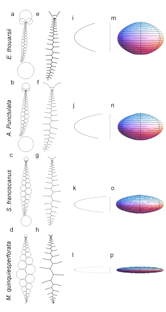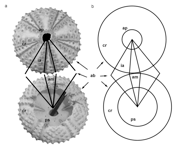
Theoretical Morphology

Echinoids have an endoskeletal system which is ideal for studying
calcified structures such as development of vertebrate skeletons.
However, understanding echinoid skeletal (test) growth has proven
challenging to analyse solely on the basis of any one approach or
process. Therefore, theoretical models have been developed to understand
growth and form of echinoid tests. Herein, Holotestoid, a computational
model of echinoid test growth is described. The model incorporates
mathematical principles (e.g., close-packing), physical principles
(e.g., interface between coalescing bubbles) and biological processes
(e.g., echinoid ontogenic processes). It is the first computational
model that emulates all five ontogenic processes involved in test growth
(plate growth, plate addition, plate interaction, plate gapping, and
visceral growth) using a geometrical representation and three analogies
(coalescing bubble, circle-packing, and catenary chains). The emulated
processes are used to predict plate size, plate shape, and test shape.
Size-Assortative Mating
Size-assortative mating is a nonrandom association of body size between members of mating pairs and is expected to be common in species with mutual preferences for body size. In this study, we investigated whether there is direct evidence for size-assortative mating in two species of pipefishes, Syngnathus floridae and S. typhle, that share the characteristics of male pregnancy, sex-role reversal, and a polygynandrous mating system. We take advantage of microsatellite-based “genetic-capture” techniques to match wild-caught females with female genotypes reconstructed from broods of pregnant males and use these data to explore patterns of size-assortative mating in these species. We also develop a simulation model to explore how positive, negative, and antagonistic preferences of each sex for body size affect size-assortative mating. Contrary to expectations, we were unable to find any evidence of size-assortative mating in either species at different geographic locations or at different sampling times. Furthermore, two traits that potentially confer a fitness advantage in terms of reproductive success, female mating order and number of eggs transferred per female, do not affect pairing patterns in the wild. Results from model simula- tions demonstrate that strong mating preferences are unlikely to explain the observed patterns of mating in the studied populations. Our study shows that individual mating preferences, as ascertained by laboratory-based mating trials, can be decoupled from realized patterns of mating in the wild, and therefore, field studies are also necessary to determine actual patterns of mate choice in nature. We conclude that this disconnect between preferences and assortative mating is likely due to ecological constraints and multiple mating that may limit mate choice in natural populations.